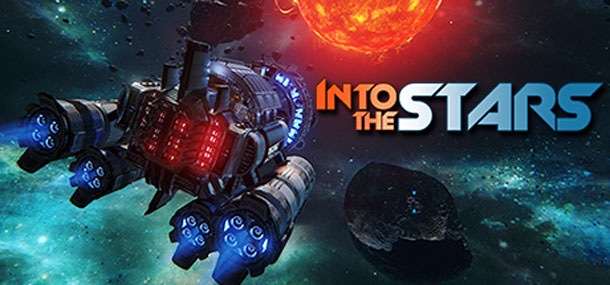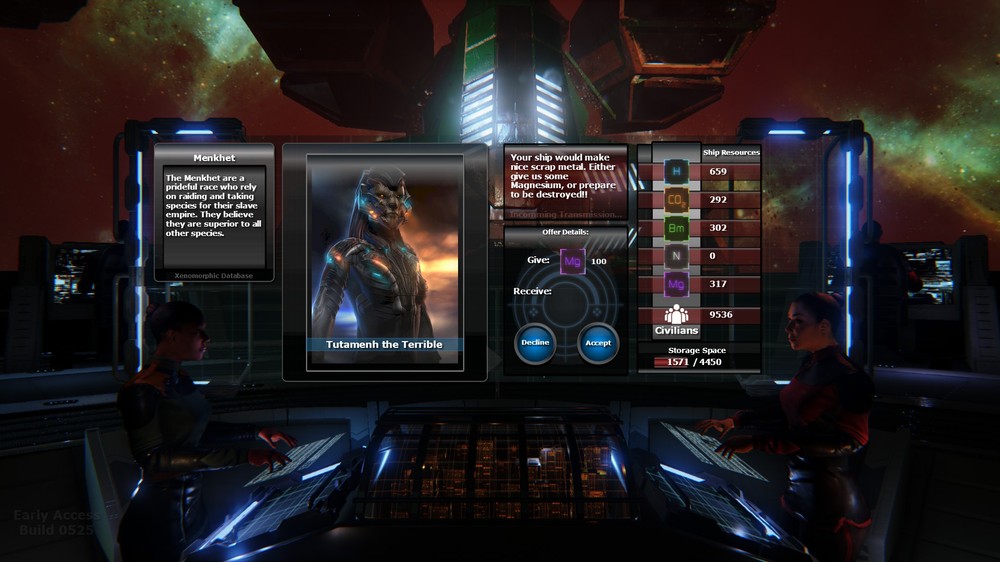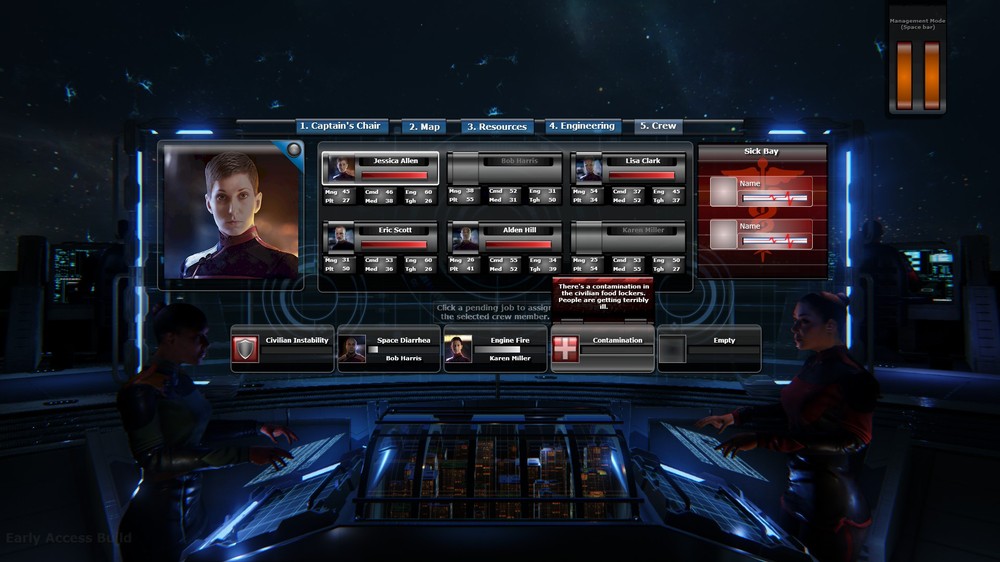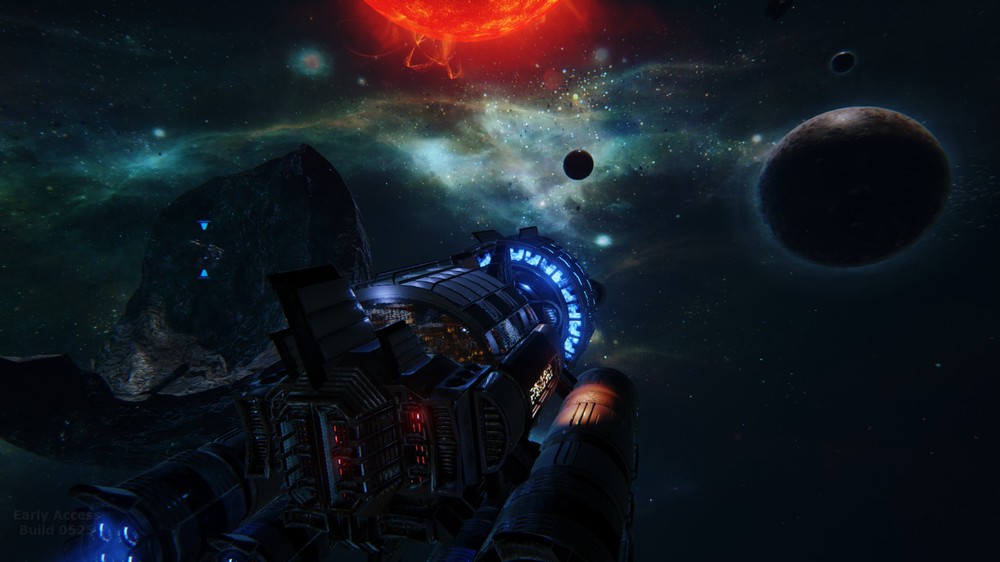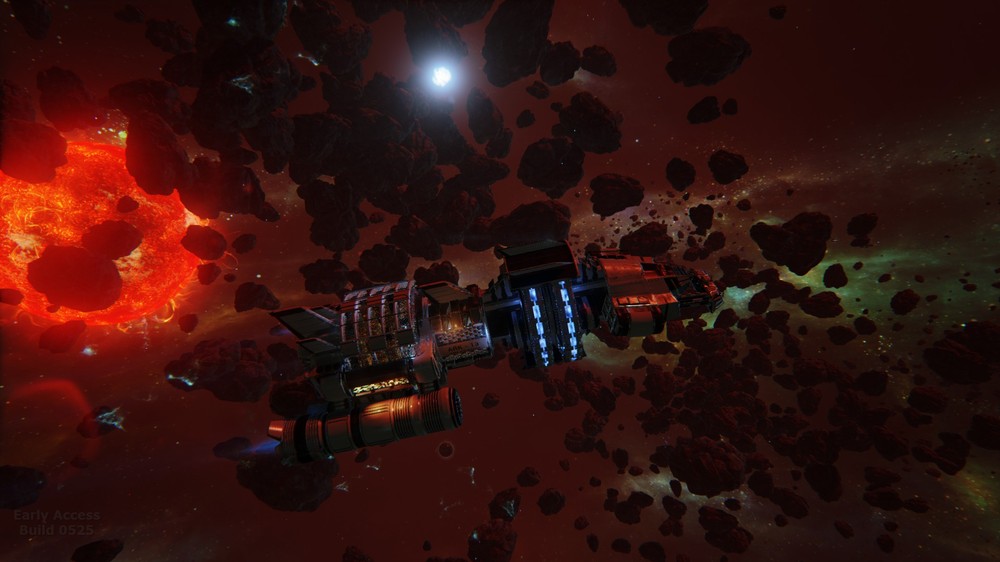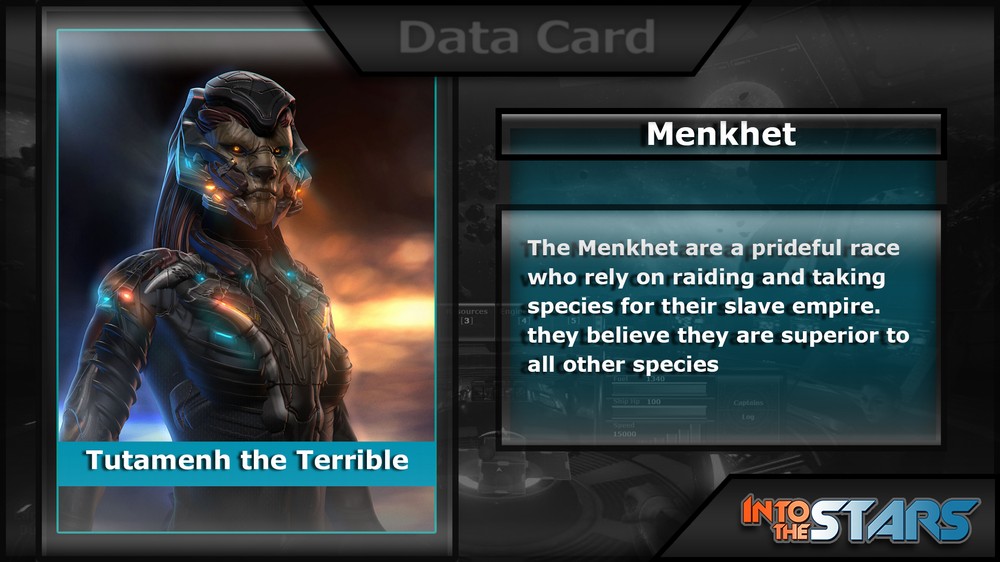Into the Stars puts you into the captain’s chair of a gigantic spaceship that is carrying the last remnants of humanity in a last-ditch effort to make it across a hostile expanse of space to a new home where they can be safe from the attacks of the evil Skorn alien race that seeks to wipe them out.
As captain, you are in control of every aspect of the ship and its 10,000 civilian inhabitants. You are charged with selecting your 6-person crew, each of whom have their own unique statistics in the 6 skill categories – Piloting, Commanding, Engineering, Mining, Medical, and Toughness. As you voyage across space, your and keeping as many of them alive as possible.
In order to survive, you must leapfrog your way from planet to planet to collect resources through away missions and mining expeditions. You can also encounter friendly alien ships that will trade with you for needed materials. But you can’t dally because the vicious Skorn are always in pursuit and will catch up with you if you sit in one place too long.
The exploration portion of the game is visually very beautiful as you glide through space in your ship between planets. However, this is the only part of the game that is particularly visually stunning. When it comes to managing the ship’s resources, civilian populations, and onboard issues, as well as all of the “away missions” and combat, the game takes on a much more static approach. Even ship to ship combat is not much more than clicking buttons at the right (or wrong) time to attack and defend in various ways. Missions on planet surfaces mostly consist of a multiple-choice scenario where you try to select the successful choice out of the three available options given to you. Success results in rewards, failure results in injury to your crew. Mining operations can be done manually, but this is done through a two-dimensional mini-game where you guide a drill down through blocks of the various materials needed to power your ship, feed your population and keep them breathing oxygen.
The fact that the only “pretty” parts of the game occur when you’re guiding your ship between destinations was a bit of a disappointment, but I will say that you are presented with enough various problems to solve that the gameplay never feels stale or boring. In my preview of the game in its early stages of development, I felt that there weren’t enough of those command decisions that were presented in order to really make me feel like I was managing a truly massive vessel across space. I feel like this version of the game gave me a lot more to be concerned about as I went. Sometimes, it was so much that I began to feel overwhelmed by decisions. But I think that’s a good thing. Success feels so much better when you can overcome the odds.
The combat, as I stated above, consists mostly of clicking the right buttons at the right time. You are armed with lasers, torpedoes, shields, and an “evade” command. The enemy ship (or ships) will have one of three colored shields selected (Red, Blue, or Yellow), which indicates their “frequency”. They will also attack you using one of those three colored weapons, as well. You must then attack them using a frequency that is different than the shield that they currently have selected and defend using the shield color that is the same as whatever frequency attack they are using. You also have to time the activation of your shields appropriately because they only stay on for a brief time before having to recharge. If you activate them too soon or too late, you will be hit. But, if you activate them at the right time on the right frequency, you take no damage. You also have the option of using the “evade” button to dodge attacks, but similar to the shield button, it has a recharge time as well. In battles that involve multiple enemies, you find yourself switching between these two options to avoid being hit as much as possible. You also have to then attack (and hit) them, which is dependent upon the skills of the crew members assigned to each station.
It sounds complex, but it is really quite simple, once you get the concept. In fights against just one opponent, I found that it was rather easy to destroy them without taking any damage at all. In battles of two or more opponents, it can get quite a bit trickier, especially when you have to remember to change frequencies often in order to both defend correctly and have your hits counted.
Though the battles are graphically very static, I still found them to be rather engaging and enjoyable because there are so many things that you have to keep in mind in order to succeed. The same, I think, can be said for most of the other things that you have to worry about in the game. Though much of it is represented either textually, or through icons or simple graphics, the variance of decisions and responsibilities that you are faced with make you really feel like you’re the captain of a gigantic vessel.
I recalled some of my favorite sci-fi shows like this, including Battlestar Galactica and Star Trek and was reminded that much of the action in the shows would be similarly unseen by the captain stationed on the bridge. Decisions would be made based on reports from various crew members, but the rest would be left to the imagination.
This realization made me accept the way the game presented the “action” in the game. It made it make sense to me. Because you are on a massive ship (it has a city inside it with a population of 10,000 people at the start) you aren’t going to see everything. Much of it is going to be reported to you by your crew and your actions are going to be mostly delegation of responsibility to your various crew members. In that way, I agree with the choices that the game made.
Success is very much about maximizing your time and resources in order to make it quickly enough across the map not to get destroyed by the Skorn, while not rushing and leaving yourself without enough supplies to survive as you go. You can slow down to make sure your fuel tank is always full, and your rations are always topped off, but you will find yourself in combat much more frequently. Conversely, you can put the pedal to the metal and make the Skorn eat your dust, but you will soon be getting reports of civil unrest, ship malfunctions, starvation, disease, and a distinct lack of the stuff that makes the engines burn so hot. Success is about finding that sweet spot between those two extremes.
Failure in Into the Stars is permanent. If your ship is destroyed or your population dies off, you will fail your mission and be forced to start again from the beginning. Luckily, a successful run probably wouldn’t take you much more than a couple of hours, if done correctly. So, if you fail, you can always try again and not feel like you’re having to start a gigantic campaign over again.
For people who enjoyed the gameplay provided in games like FTL, I would say that Into the Stars is in a similar vein and up your alley. However, if you were hoping for action-packed 3D combat, this is not that game.

